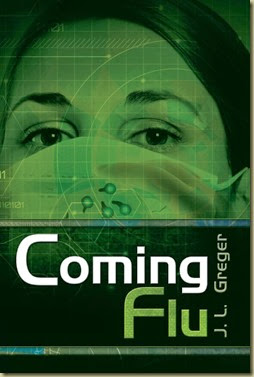 It’s always an honor when I get to introduce a ‘new-to-me’ author to y’all as it’s fun to learn about the writer and their books. Today I’d like to welcome author J.L. Greger to Thoughts in Progress. She’s going to talk about ‘Science in Fiction,’ as well as share a bit about her books.
It’s always an honor when I get to introduce a ‘new-to-me’ author to y’all as it’s fun to learn about the writer and their books. Today I’d like to welcome author J.L. Greger to Thoughts in Progress. She’s going to talk about ‘Science in Fiction,’ as well as share a bit about her books. Welcome, J.L.
Do readers want science in their fiction?
In 2013, at least fifteen TV shows featured realistic portrayals of science, medicine or technology. Before I continue, I should define realistic. Real labs can’t provide analyses instantly as shown on TV, and most scientists don’t have perfect hair. Even so, the popularity of TV shows suggests viewers, and presumably readers, like bits of science in their fiction.
Fiction that focuses on realistic science is called “science in fiction,” not science fiction. Many of the writers of science in fiction, like me, were or are practicing physicians or scientists. In one sense, this isn’t a new phenomenon. Arthur Conan Doyle and Robin Cook were physicians.
What’s important in science in fiction?
Accuracy. In my third novel, my heroine Sara Almquist learns silver miners in Bolivia carry little food or water into the mines. In order to endure the pain caused by thirst, hunger, and heavy exertion at a high altitude (13,000 feet), they chew coca leaves. The active ingredients in coca leaves and its derivative cocaine are not analgesics that dull pain. They are stimulants and help users ignore pain. Accordingly I named the book IGNORE THE PAIN not Dull the Pain.
In case you think the facts seem a bit dry, here’s a synopsis of the action. Sara Almquist couldn’t say no when invited to be the epidemiologist on a public health mission in Bolivia. Soon someone from her past is chasing her through the Witches’ Market of La Paz and on to the silver mines of Potosí. Unfortunately, she can’t trust her new colleagues, especially the charming Xave Zack, because they might be under the control of the coca industry. Worst still she’s not only put herself in danger but also her sister, Linda, back in New Mexico.

Excitement. As a biologist, who regularly reads scientific journals, I am amazed how easily a few mutations can change a fairly benign flu virus into a virulent one. A variant of the common H1N1 flu virus killed three percent of the world’s population between 1918-20, and the wrong mutation to a flu virus today could kill millions if scientists weren’t prepared.
In COMING FLU, a new flu virus hits a small, walled community near the Rio Grande. A quarantine is declared because experimental vaccines and antivirals are ineffective against this flu mutation. Epidemiologist Sara Almquists pries into the lives or everyone in the community looking for way to slow the spread of the flu. She finds promising clues - maybe too many.
Relevant science. Almost all Americans are interested in easy ways to lose weight. Scientist know fat animals (including humans) lose weight when their gut bacteria are altered, but scientists don’t know which of the 15,000 to 36,000 species of bacteria in the gut are important. I thought descriptions of this research (based on current ongoing studies) would be intriguing, maybe slightly funny, to readers.
 In MURDER: A NEW WAY TO LOSE WEIGHT, a diet doctor is found dead after she charges her partner with recklessly endangering the lives of obese subjects in their clinical trials. Linda Almquist, the associate dean in the medical school, must protect the subjects in the clinical trial, while she searches for a sophisticated killer who knows a lot about drugs.
In MURDER: A NEW WAY TO LOSE WEIGHT, a diet doctor is found dead after she charges her partner with recklessly endangering the lives of obese subjects in their clinical trials. Linda Almquist, the associate dean in the medical school, must protect the subjects in the clinical trial, while she searches for a sophisticated killer who knows a lot about drugs. Would you like to read a science in fiction novel?
BTW, Bug, my Japanese Chin dog and character in all three of my novels, says hello to Traveler, the resident cat at Thoughts in Progress.
J.L., thanks for joining us today and sharing this difference in science fiction and science in fiction. All three books sounds like they are quite intriguing ‘science in fiction’ stories. And, Traveler sends a hello back to Bug.
Now for a bit of background on J.L.
J.L. Greger is no longer a professor in the biological sciences at the University of Wisconsin-Madison, instead she’s putting tidbits of science into her medical mystery/suspense novels.
For more on J.L. and her writing, visit her website, check out her blog, JL Greger’s Bugs, and her Amazon link.
Thanks so much for stopping by today and visiting with J.L. Had you ever considered the difference in ‘science fiction’ and science in the fiction’ writing?
*This post contains affiliate links.









J.L., thanks again for visiting with us. You've given us interesting information to consider when thinking about science and fiction. Wishing you much success.
ReplyDeleteMakes you realize how close to the edge our science walks.
ReplyDeleteThe one about the flu in NM is scary. About the time we moved from NM to NC, the hanta virus made its appearance and killed several people.
ReplyDeletefantasy and imagination are my fave element in sf.
ReplyDeleteMason - Thanks for hosting J.L.
ReplyDeleteJ.L. - I couldn't agree more about the importance of accuracy in a novel, especially when there are science themes involved. I wish you success.
I think science greatly enhances a story..and can also make it terrifying.
ReplyDeleteMason, Thanks for hosting me.
ReplyDeleteI'm glad many of you think science adds realism to a novel. Diane, I think Murder: A New Way to Lose Weight is scary because it shows what can go wrong on a clinical trail and how easy it is to poison someone.
Janet's science background enhances a good series with intriguing characters.
ReplyDeleteI would like to see "Science in fiction" better understood, so thanks for the post. I also write this, partly to make the story more interesting, but partly to show how science works. In my ebook "Athene's Prophecy" I give the reader a challenge. The protagonist, amongst other things, has to prove the earth goes around the sun, using information available at 40 AD. Could you do it? Answer is in the following ebook.
ReplyDelete